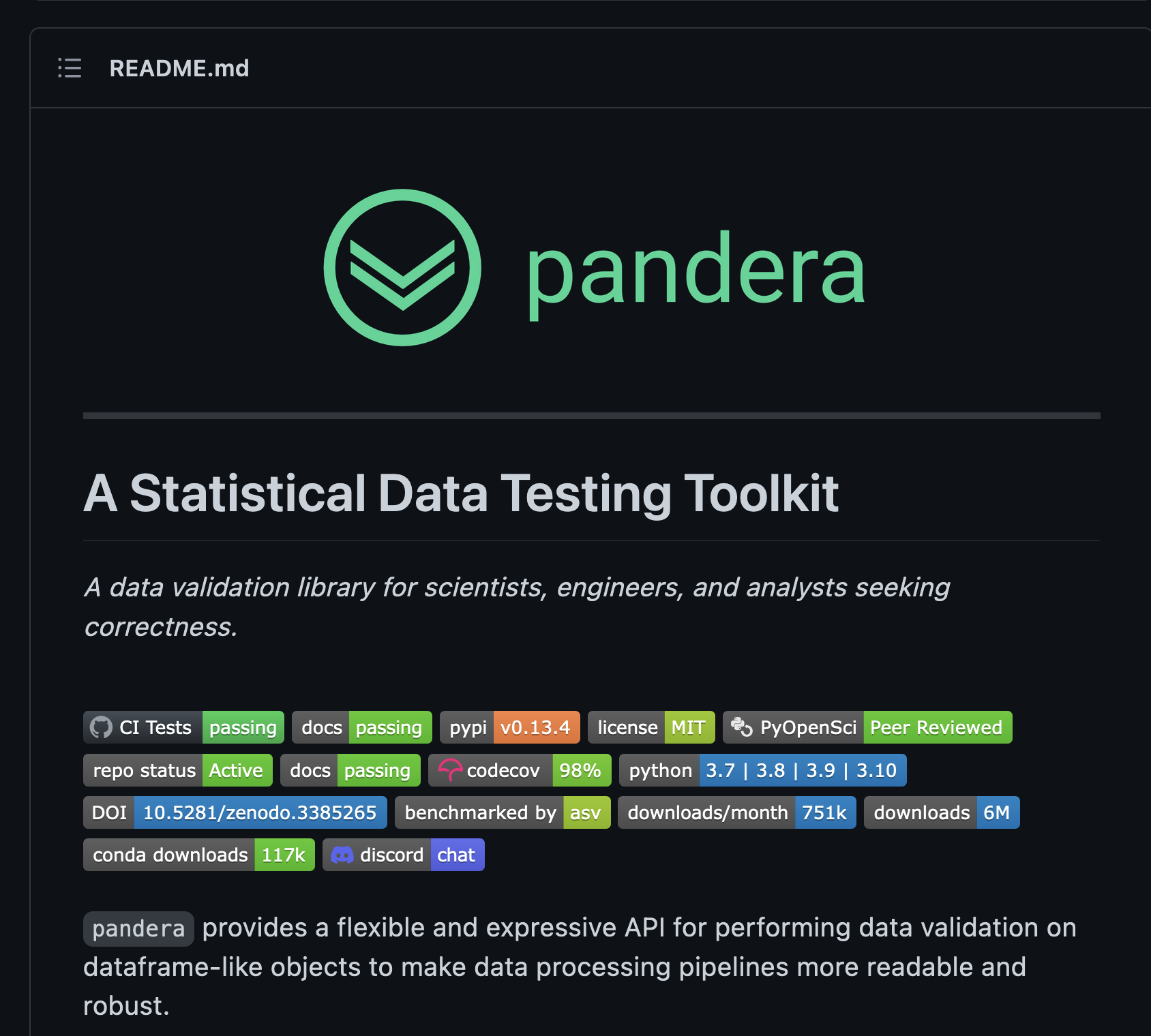README File Guidelines and Resources#
Your README.md file should be located in the root of your GitHub repository. The README.md file is important as it is often the first thing that someone sees before they install your package.
The README.md file is the landing page of:
Your package as it appears on a repository site such as PyPI or Anaconda.org
Your package’s GitHub repository
Your README.md file is also used as a measure of package and community health on sites such as:
GitHub community health for MovingPandas (available for all repositories) and Snyk - MovingPandas example

Your GitHub repository landing page highlights the README.md file. Here you can see the README.md file for the pyOpenSci package Pandera. (screen shot taken Nov 23 2022)#
Thus, it is important that you spend some time up front creating a high quality README.md file for your Python package.
Note
An editor or the editor in chief will ask you to revise your README file before a review begins if it does not meet the criteria specified below.
Please go through this list before submitting your package to pyOpenSci
### pyOpenSci README checklist
Your README file should have the following information:
- [ ] The name of the package
- [ ] Badges for the packages current published version, documentation and test suite build. (OPTIONAL: test coverage)
- [ ] Easy-to-understand explanation (2-4 sentences) of what your tool does
- [ ] Context for how the tool fits into the broader ecosystem
- [ ] If your library/package "wraps" around another package, link to the package that it is wrapping and any associated documentation. *(HINT: If you don't know what a wrapper is, this probably doesn't apply to you!)*
- [ ] A simple quick-start code example that a user can follow to provide a demonstration of what the package can do for them
- [ ] Links to your package's documentation / website.
- [ ] A few descriptive links to any tutorials you've created for your package.
What your README.md file should contain#
Your README.md file should contain the following things (listed from top to bottom):
✔️ Your package’s name#
Ideally your GitHub repository’s name is also the name of your package. The more self explanatory that name is, the better.
✔️ Badges for current package version, continuous integration and test coverage#
Badges are a useful way to draw attention to the quality of your project. Badges assure users that your package is well-designed, tested, and maintained. They are also a useful maintenance tool to evaluate if things are building properly. A great example of this is adding a Read the Docs status badge to your README.md file to quickly see when the build on that site fails.
It is common to provide a collection of badges towards the top of your README file for others to quickly browse.
Some badges that you might consider adding to your README file include:
Current version of the package on PyPI / Anaconda.org
Documentation build - Example:
Tip
Once you package is accepted to pyOpenSci, we will provide you with
a badge to add to your repository that shows that it has been reviewed.
Caution
Beware of the overuse of badges! There is such a thing as too much of a good thing (which can overload a potential user!).
✔️ A short, easy-to-understand description of what your package does#
At the top of your README file you should have a short, easy-to-understand, 1-3 sentence description of what your package does. This section should clearly state your goals for the package. The language in this description should use less technical terms so that a variety of users with varying scientific (and development) backgrounds can understand it.
In this description, it’s useful to let users know how your package fits within the broader scientific Python package ecosystem. If there are other similar packages or complementary package mentions them here in 1-2 sentences.
Tip
Consider writing for a high school level (or equivalent) level. This level of writing is often considered an appropriate level for scientific content that serves a variety of users with varying backgrounds.
The goal of this description is to maximize accessibility of your README file.
✔️ Installation instructions#
Include instructions for installing your package. If you have published the package on both PyPI and Anaconda.org, be sure to include instructions for both.
✔️ Document any additional setup required#
Add any additional setup required such as authentication tokens, to get started using your package. If setup is complex, consider linking to an installation page in your online documentation here rather than over complicating your README file.
✔️ Brief demonstration of how to use the package#
This description ideally includes a brief, quick start code example that shows a user how to get started using your package.
✔️ Descriptive links to package documentation, short tutorials#
Include descriptive links to:
The package’s documentation page.
Short tutorials that demonstrate application of your package.
Too Much Of A Good Thing
Try to avoid including several tutorials in the README.md file itself. This too will overwhelm the user with information.
A short quick-start code example that shows someone how to use your package is plenty of content for the README file. All other tutorials and documentation should be presented as descriptive links.
✔️ A Community Section with Links to Contributing Guide, Code of Conduct#
Use your README.md file to direct users to more information on:
Contributing to your package
Development setup for more advanced technical contributors
Your code of conduct
Licensing information
All of the above files are important for building community around your project.
✔️ Citation information#
Finally be sure to include instructions on how to cite your package. Citation should include the DOI that you want used when citing your package, and any language that you’d like to see associated with the citation.
README Resources
Below are some resources on creating great README.md files that you might find helpful.


